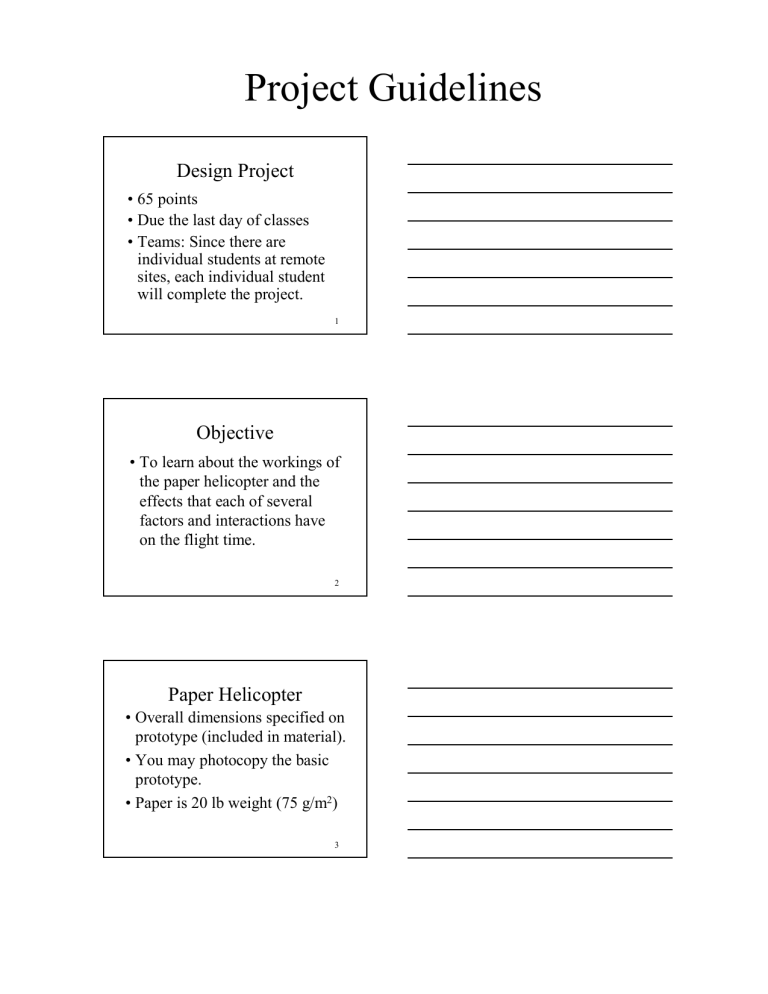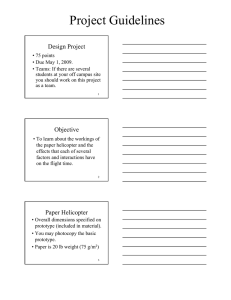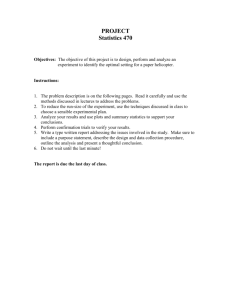Project Guidelines Design Project

Project Guidelines
Design Project
• 65 points
• Due the last day of classes
• Teams: Since there are individual students at remote sites, each individual student will complete the project.
1
Objective
• To learn about the workings of the paper helicopter and the effects that each of several factors and interactions have on the flight time.
2
Paper Helicopter
• Overall dimensions specified on prototype (included in material).
• You may photocopy the basic prototype.
• Paper is 20 lb weight (75 g/m 2 )
3
Project Guidelines
Response
• Time (in seconds) from release until the helicopter hits the floor. The paper clip should hit first and will make a noise on a hard surface. Measurements should be to 0.01 seconds.
4
Factors
• A: # of paper clips: 1 to 3
• B: wing length: 5 cm to 10 cm
• C: wing width: 2.5 cm to 4.5 cm
• D: wing fold: standard or with fold
• E: tail length: 5 cm to 10 cm
• F: body: standard or with fold
• G: height: 1 m to 3 m
5
Particulars
• paper clips? at bottom, centered.
• tail length? fold over extra.
• wing length? cut appropriately.
• wing width? cut from center.
• drop height? bottom of copter.
• launch? you decide!
6
Project Guidelines
Analysis of Data
• What factors and interactions are statistically significant?
• Prediction equation using only those terms that are statistically significant.
7
Confirmatory Runs
• Once you have your prediction equation use it to design a helicopter that will maximize the flight time.
• Confirm that such a design has the maximum flight time.
8
Report
• Executive summary
– One or two paragraphs that describe what you have learned.
– Final prediction equation.
• Description of experiment(s)
9
Project Guidelines
Report
• Analysis of data
• Summary
• Appendix
– List all the data collected including treatment combinations and run order.
Include data as an attachment (text file or .jmp or .xls)
10
Report
• The reports will NOT be returned. It is your responsibility to make a copy for yourself.
11
Report
• Write the report so that someone with little or no knowledge of statistical jargon can understand it.
An important part of statistics and experimentation is being able to communicate results effectively.
12
Project Guidelines
Report
• A sample of a report in this style is on the course web page. Follow the link to Example project write up from
Spring 1997. Note that the project was different from the one you are assigned. Do the project as assigned this semester not the one that appears in the example project.
13
Grading Criteria
• Prediction equation: 5
• Completeness: 10
• Efficiency: 10
• Analysis: 25
• Confirmatory runs: 5
• Quality of report: 10
14
Evaluation
• Each student will receive a critique of the project: experiment(s), prediction, analysis and report.
• Each student will also receive a score based on the grading criteria.
15





